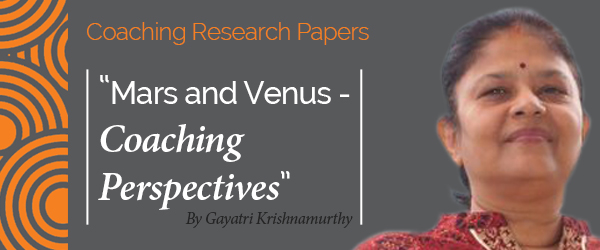Research Paper By Gayatri Krishnamurthy
(Executive Coaching, INDIA)
Introduction
Women are indeed from Venus. Men are from a place other than Venus. I was in Las Vegas and I went to watch the immensely brilliant show by Penn and Teller. Before the show began, audience members were encouraged to go up on stage and sign an envelope and view and examine a box kept on stage. Men, women and children flocked to the stage. There were 2 flights of steps with an usher each by the side. Children hardly noticed the usher. All men sidestepped the usher’s extended hand and walked down on their own. 95% of women took the usher’s hand as they came down the steps. I was also noting whether there were any differences like stilettos, health, bulk etc which distinguished these women. That was not the case. So whether or not a woman needs help, she will feel obliged to hold an extended hand. This and many other observations made me curious about the popularly perceived associations between gender and coaching style as well as client behaviours. This could be helpful in both positioning the coach’s offerings as well as in selecting an appropriate coach.
Sheena Iyengar, now the inaugural S.T. Lee Professor of Business in the Management Division at Columbia Business School conducted a multiyear study with the economists Raymond Fisman, Emir Kamenica, and Itamar Simonson to determine what men and women desire in a mate. Among other things, the experiments revealed that women of all races strongly prefer a romantic partner of the same race and that women place more emphasis on a mate’s intelligence, while men tend to favour physical attractiveness
Executive coaching seems to be an equal opportunity industry. Both men and women thrive in a coaching career
Objective
- Find out if there are gender based differences in coaching profession.
- Are these differences the same in India and in countries where coaching is a more mature profession.
- What can be our learning from sociology and biology which would help us become better coaches?
Some of the aims of exploring the differences in approach and expectations are:
Methodology
Primary and secondary data from books, articles and existing surveys was scanned .Interview were done using a structured questionnaire. The survey was administered to people who had more than 15 years experience and were exposed to the concept of coaching. The data from all these sources were collectively analysed to look for significant trends.
Data and Findings
There were a total of 15 respondents on the whole had coached from a minimum of 10 up to 200 clients. Most of the clients whom they coached were sponsored clients. The client profile which hired the respondent population were as shown below:
Male – 11%
Female – 89%
It is observed that the overall trend is towards 10% of the coaches being females. This is borne out by the above graph.
The distribution of sponsored clients and individual clients and the gender distribution are given in the following 2 figures.
Sponsored vs Individual
Individual – 13%
Sponsored – 87%
The gender spread is shown in the figure below.
Gender Spread
1 2 3 4 5 6 7 8 9 10 11 12 13 14 15
Female 80 1 10 8 12 5 14 12 8 15 10 1 9 1 10
Male 180 9 90 2 123 20 21 13 32 15 190 9 31 10 160
As part of the seventh annual Sherpa Coaching Survey, gender in coaching and related professions were looked into, to see what’s changing and what remains the same.
This survey was conducted in a developed nation, Here Women dominate certain coaching professions, and hold their own in others. In the developed world and in particular the US women make up:
In our own ICA classes while international enrolment has more than 75% women students, enrolment in both our face to face classes in Bangalore and overall in India is hardly 25%.
I asked the respondents about their experience as clients from a gender spread perspective. The gender spread of the coaches selected by the respondents is shown in the figure below.
